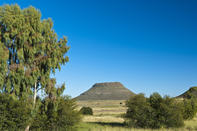Named After Sir Lowry Cole
Passing through the Northern Cape on the Cape-to-Cairo road, a stark and symmetrical hillock rises 1 707 m high from the flat landscape. It is here that you will find the town of Colesberg, the hillock named Cole’s Kop accordingly. The hillock was a landmark for pioneer travellers years ago, who compared it to a great mountain that towering (Toringberg), enchanted (Tooverberg) and full of wrath (Toornberg).

A marsh at the foot of the hill provided water to game animals in the otherwise dry area and in 1814 the site was made into a mission station by Erasmus Smit. In 1818 the Cape Government ended the mission work. The farmers who resided on the land put a petition forward in 1822 for the area to be established as a town and in 1830 the first plots of land were sold.
The new town being named after Sir Lowry Cole who was the Cape Governor at the time. Colesberg started trading with other towns and, being successful in their endeavours, became a municipality in 1840. Colesberg then became a stock breeding area for horses, sheep and cattle which thrived in the climate.
Home to Over 12 000

Much time has passed since then and present day Colesberg in now home to over 12 000 people, although the architecture in the main street is reminiscent of a century ago. The churches in Colesberg are worth a visit: the Dutch Reformed with its striking white walls and the Anglican with rare books, oak furnishes and beautiful stained glass windows.
The museum in Colesberg houses a window pane with the letters DP carved onto the surface. The carving was made using the first diamond ever found in South Africa. Many Anglo-Boer War battle sites are also located around Colesberg.